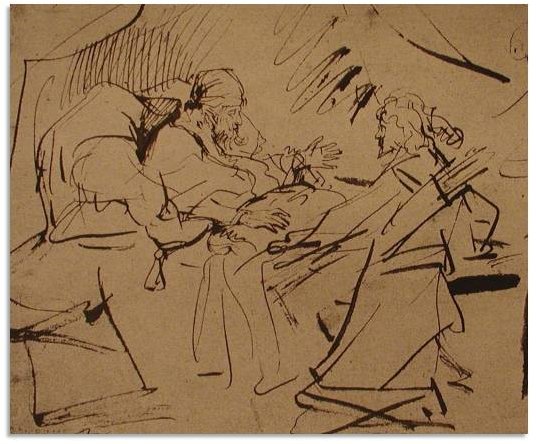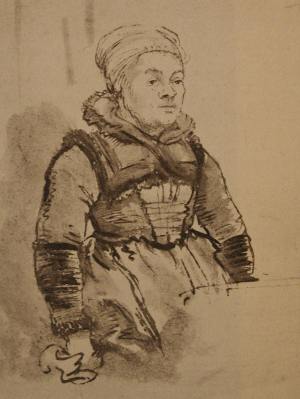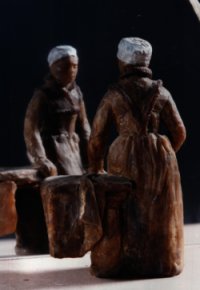We usually subscribe to the idea that imagination is the most important quality in a work of art. We believe that imagination means not looking at life but drawing from ones' head. Rembrandt, Coleridge or Wordsworth, three imaginative geniuses, would not have countenanced that idea for one moment. But we, for several generations, have accepted this idea without question. It’s within our culture and it’s wrong.
The physical relationships that Rembrandt set up for his live model groups were a necessary part of his creativity. He empathised through these characters and he observed the relationships he had created between them. This empathy, plus his profound observation of humanity and his stage production constitute the three aspects of his true imaginative genius.
What Rembrandt learned about the psychology of humanity through his use of live models and their interactions with one another is an important part of our inheritance. Rembrandt can teach us to understand the human condition through observing body-language, and to see the psychological interaction between people. Rembrandt was able to perceive the spirit in the physical world and convey it in his drawings. This is his great gift to us. We cannot afford to allow it to be obscured.
Spatial Relationships
I think that Rembrandt was the first artist in history to realise that the way people relate to each other spatially is the key to our perception of the psychological world. Rembrandt's spatial relationships make clear to the observer, the thoughts and feelings of his characters. Rembrandt had this psychological and dramatic gift above anyone else. For example we saw in The Death-bed of David how the poses of the figures expresses their state of being. The drawing conveys all the subtleties of their life's relationships. Their spatial disposition gives us the precise visual equivalent of what the Bible describes in words. This masterpiece is the result of observation. The element of invention enters only into the 'production' of the model group. (See note 1).
Esau and Isaac
In the Isaac and Esau drawing we saw the two aspects of Rembrandt both from observation and from invention. In this final example (Jupiter with Philemon and Baucis) Rembrandt is drawing entirely out of his head. We see him so dissatisfied with the result that he has had to write the story on the right of the drawing. This drawing is so untypical of Rembrandt, no one would have thought of him as the draughtsman but for his recognisable script.
Isaac Refusing to Bless Esau

See article - Isaac Refusing to Bless Esau
Click on the image above for a full treatment of this drawing and how it can teach us about Rembrandt's imagination, his character and his strengths and weaknesses as an artist. For Rembrandt "imagination" does not mean drawing out of ones head head. He always drew from life when possible.
Woman In North Holland Dress
Example Showing the Different Quality to Expect from Rembrandt when Drawing from Reality and from Reflection in a Mirror - And His Refusal to Draw from What We Call the "Imagination".
This example shows how Rembrandt makes a superb drawing of her back; it is one of the greatest drawings. It has got all the sense of the physicality; the sense of the light coming off the hat, and through the fur. It is an absolutely gorgeous drawing. The front view which is observed in the mirror is very dull and he has not drawn in one hand. The real body was not allowing him to see the hand in the reflection. He could not see it, so he would not draw it. (see maquette below)



Maquette
When it comes to painting it can be a slow process. You have all the time in the world to change your mind, repaint, scrape out, etc. but in the drawings Rembrandt really shows his hand. On occasions one sees his absolutely virtuoso brilliance and on other occasions, even when he was drawing from life, he could produce simply appalling works. I have no explanation for that. I can explain lots of things from the lack of presence of models but occasionally one knows there was a model there and
Rembrandt produced a pretty ghastly life drawing. One of the most interesting things about Rembrandt is that he did not care. You know he is on his way somewhere. He does an awful drawing and puts it aside. Michelangelo would have had one of his bonfires and cleaned up his reputation. Rembrandt did not. As far as my own understanding of Rembrandt goes he is completely transparent. He makes no bones about his inability to draw without visual reference.
Note 1
Arnold Houbraken was very clear about Rembrandt's methods “ he would not attempt a single brush stroke without a living model before his eyes. Our great Rembrandt was indeed faithful to the principle that one must follow only nature, anything else was worthless in his eyes”.
Roger de Piles said the same, “he had a wonderful talent for reproducing concrete subjects” J. von Sandart also: “ he asserted that one should let oneself be guided by nature and by no other law.”
Is there any room for doubt about Rembrandt's methods?
